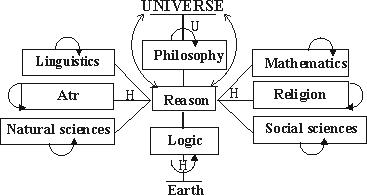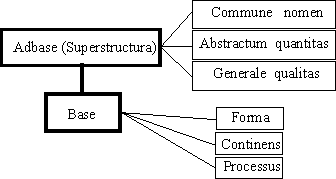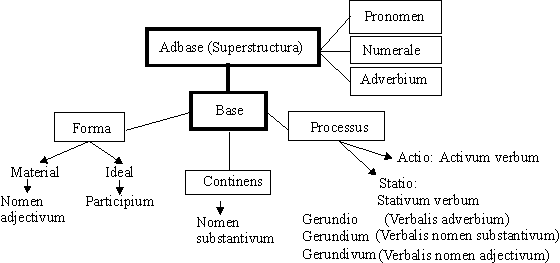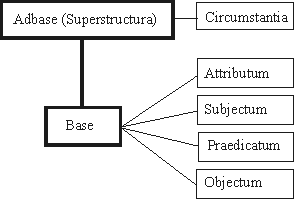
MATHEMATICAL EXPRESSION OF THE MAIN CATEGORIES OF PHILOSOPHY AND LOGIC
L. G. Kreidik, Dialectical Academy, Russia-Byelorussia
Translation from Russian
T. S. Kortneva and G. P. Shpenkov
1. Introduction
1.1. The graph of sciences
The Universe is a dialectically contradictory complicated system-set with an infinite series of mutually intersecting material-ideal levels of matter-space-time. The Life and Reason on the Earth is manifestation of one of its material-ideal levels with its history, some of which occur on the Earth. The Earth's history of Reason (language, consciousness, thinking) is the history of Humans-Universe (H-U) and humans-humans (H-H) relations, and in the space of these relations, sciences are being developed. Sciences form a system of knowledge which continuously develops and evolves. Occasionally, evolution is changed by discrete of revolutionary development and in these periods the previous knowledge is reviewed. Continuity and discreteness are a characteristic feature of any process in nature and sciences are not an exception.

Fig. 1.1. The graph of sciences.
The main characteristic feature of sciences is their self-motion and non-self-motion. In this respect the contemporary system of sciences can be represented by a graph, the edges of which express the interdependence, non-self-motion of sciences, and the loops represent their internal relation, self-motion (Fig. 1.1).
The node of the graph is dialectical philosophy which generates any philosophical systems at definite logical variations. This can be explained by the fact that dialectical philosophy has been developed for the space of millennia in close interaction with all philosophical systems. In what follows, while speaking about philosophy and logic, we will further mean dialectical philosophy and logic which form together the unique system-dialectics.
The core of the graph is dialectical logic, from which any logics follow at some simplified approaches. The bases of the graph (natural and social sciences) dispose by the source of special sciences. Sides of the graph (linguistics and mathematics) systematize the ideas about qualitative and quantitative languages of science, between of which is deep correlation. Philosophy and logic, language and mathematics are related directly and indirectly with religion and art. The graph of sciences includes implicitly sciences studying these sciences, we will call them ectosciences (from the Greek, ektos = outside). The notion of ectoscience is similar to the notion of metascience in the contemporary science but the latter notion is a little narrower than ectoscience. Ectoscience can be defined by the formula:
ectoscience = science + dialectics + specific sciences
In particular, ectologic is a system of sciences that contains logic, dialectics, and specific sciences. Specific notions and methods of the theory of logic are formed in this system.
Science, in comparison with ectoscience, can be naturally named endoscience (from the Greek, endo = inside), i.e. internal science.
1.2. Ectolinguistics
Linguistics is an important element of cognition of the Universe and it is the first level of logical thinking. At depths of linguistics, ectolinguistics is being generated gradually. It connects the origin of languages and their etymology with Nature.
The Earth and Cosmos had approximately the same effect on people, forming their languages, therefore national languages should be interpreted as sublevels of one and the same language of the Earth and Cosmos.
In contemporary high-level languages words are represented by name-words (lexemes) and relation-words (lexas) that are not separated by a clear-cut boundary. The relation words, expressing the connection between the lexemes originate from the latter. Many lexas became shorter with time and lost any relations with the lexemes that generated them. They became absolute lexas that are abstract sounds. For example, a human hand has been playing an important role in indication of particular relations. Because of this, the name of the hand formed the lexa "and". Many examples can be taken from various languages of the planet.
In the Chinese language, the ancient name of the right hand and the conjunction-lexa "and" are depicted by the same hieroglyphic and both are pronounced as "iu". The lexeme "hand", in English, German, and Danish, formed the lexas "and", "und", and "end", respectively. In Spanish, the lexeme "ademan" (gesture) corresponds to the lexa "ademas" (and, yet, even, also). In the Hindi language, "hasta" (hand) has some related words in Spanish: "hasta" (hand), "esta" (to be), and the conjunction "hasta" (and). By the way, "hasta", "esta" and Russian word "kist" (hand) are of the same origin. In Vietnamese, the sound "voi" (that means to reach with a stretched arm) is the same as for the lexa "voi" (and), etc. Relative lexas are expressed by combinations of lexemes and lexas.
All variety of lexas in languages of the high level is disintegrated into a series of parts of speech or grammatical factor sets. Words equal on the definite functional criterion are elements of these factor sets. It is impossible precisely to demarcate such sets because they are always rather fuzzy. The grammatical factor sets reflect definite sides of nature, which can consider as objective factor sets of nature itself. Thus, they are images of factor sets of originals. Characteristic sets reflecting definite relations of the real World are a part of the grammatical factor sets.
The factor sets of the grammatical level of any high level language are formed under action of Environment and Cosmos.

Fig. 1.2. An abstract graph of the basis-superstructure.
Based on Latin language, we will consider an abstract graph of basis-superstructure (Fig. 1.2). Nature, as the complex of objective basis-superstructure (base-adbase or base-superstructura), induces in human consciousness a triad of the basis: form (forma), contents (contienes), process (processus); and a triad of the superstructure: a common name of an object of thought (commune nomen), abstract quantity (abstractum quantitas), and quality of relatively common character (generale qualitas).
At the grammatical level, the objective basis and superstructure form the subjective morphological structure of the basis-superstructure (Fig. 1.3).
At the level of the superstructure, common names form the factor set pronomen (pronoun); the abstract quantities form the factor set numerale (numeral); the general qualities form adverbium (adverb) factor set.
At the level of the basis, a material form is expressed by the factor set nomen adiectivum (adjective) and an ideal form is presented by the characteristic set participium (participle).
Contents symbolizes the factor set nomen substantivum (noun).

Fig. 1.3. A morphological graph of the basis-superstructure of the grammatical level.
Process is expressed by the factor set verbum (verb) and decomposed into two subsets of verbs, action (actio) and state (statio) verbs.
A verb of the subset activum verbum (the subset of action) is also termed as transitivum verbum (transition verb), whereas a verb of the subset stativum verbum (the subset of state) is termed as intransitivum verbum (intransitive verb).
The subsets of state describe characteristic sets: gerundio (verbal adverb, gerundio), gerundium (verbal noun, gerund), and gerundivum (verbal adjective, gerundive).
The components of characteristic sets are contradictory. They are intermediate between verbs and corresponding parts of speech, therefore, they have simultaneously peculiarities of both, the verbs and parts of speech.
The set gerundio is in Russian (and all Slavonic languages), Spanish, Hindi, and other languages of peoples of India. This set is not in English, French, and German languages; the last languages have the gerund-set which is not in the previous mentioned languages.
If certain set or subset is explicitly absent in a language, i.e. it has not a synthetic form, then the set is expressed implicitly in an analytical form. For example, gerundio has not a synthetic form in German, French, and English languages, where it is expressed analytically. In Russian, gerundio has the synthetic form and it is described synthetically, but gerundium is expressed analytically.
Participium is termed, in Russian, "prichastie" (participle). It is the unfortunate name because it does not express the essence of this notion, moreover, this word reflects with the definite sense the spiritual life of Orthodoxy (communion). Participium has traits of verb and adjective, therefore, its should be named as "active adjective" or briefly "actadjective". Such name indicates the relation of the notion with verb and adjective and reflects the functional essence of this grammatical structure. The same can say about gerundio, which is termed "deeprichastie" (gerund), whereas in essence it is "active adverb" ("actadverb").
A word must represent the form and reflect the logical contents of a notion, but it has not only to name the notion. A word, calling a notion and expressing its contents, is the most preferable. If a form and contents of a word are not agree between themselves, it is not proper word.
Basis and superstructure, as the morphological level of a language, have the proper superstructure, the syntactical level (Fig. 1.4). The syntactical level, as the complex superstructure, has own basis: a set of subjective contents, subiectum (subject); a set of objective contents, objectum (object); a set of form, attributum (attribute); a set of motion and state, praedicatum (predicate).
Circumstantia (adverbial modifier) represents the superstructure of the syntactical level, which decomposes into a series of subsets with own functions similar to adverb.

Fig. 1.4. A syntactical graph of the grammatical level.
Verbs of motion and state, representing in a sentence elementary quanta of thought, express definite self-relations of a subject, object, environment (ambitus) and relations between them. The main peculiarity of these relations and self-relations is the definite directedness which is expressed both by syntactical forms of a verb and analytically.
We will call tendencia (tendency) a set of verbal forms of the directedness of a process. In more or less extent, the set of tendencia is presented in contemporary languages by the different forms of voice. Verbs of zeroth directedness should be referred to the tendencia set, because the set will not be complete without them. In such a case, the infinitivum (infinitive) form of a verb, meaning an action or state by itself, will be belong to the zeroth directedness.
In Russian language, the name "zalog" has formed from Grecian name a diathesis. This many-valued word means "disposition, placing, character" and "investment of means, money". Greek thinkers have applied the word, naturally, in the meaning of the "disposition, character" verb. Unfortunately, the word diathesis has entered in Russian grammar also with interpretation as "deposit, pledge, investment of means, money". It is desirable the word "zalog" in grammatical meaning, as voice, to change on the word corresponding to the notion "character, tendency".
In Greek, English, French, German, Italian languages, the name of voice means "word, expression, opinion, judgement" that is near to the essence of this notion.
The set of tendency is decomposed into eight subsets-tendencies:
1) the direct tendency describes an action purposeful from a subject to an object (genus activum, active voice);
2) the inverse tendency describes an action directional from an object to a subject (genus passivum, passive voice);
3) the mutual tendency describes a mutual action between a subject and an object (genus mutuum, mutual voice);
4) the multivariate tendency describes a multivariate relation of subjects and objects (genus plurativum, plural voice);
5) the proper tendency describes a proper action of a subject (genus proprium, proper voice);
6) the reciprocal tendency describes a reciprocal action of a subject (genus reflexum, reflexive voice);
7) the tendency of state describes a state of a subject (genus stativum, state voice);
8) the zeroes tendency names an action or state (genus nominativum, nominal voice).
The set of tendency is complete, i.e. this set involves all verbs, whereas the set of voice is only the subset of the set of tendency.
Verbs reflect also possibility, reality, and motive to action or state. Inducement can be personal, public and natural character. These peculiarities of being are expressed both analytically and synthetical by means of such characteristic sets as:
1) a set of modus indicativus (indicative mood);
2) a set of modus conjuctivus (conjunctive mood);
3) a set of modus imperativus (imperative mood).
Temporal relations are expressed, analytically and synthetically, by three groups of verbal forms of past, present and future time. Every from these times analytically and synthetically is in turn represented, mainly, by three time types of duration: continued, perfected, and indefinite time.
Lexemes and lexas, as acoustic informational formations, are contradictory discontinuous-continuous structures. The discontinuous side of lexemes is represented by discrete phonemes (consonant sounds), the continuous side, by indiscrete phonemes (vowel sounds). Contradictory phonemes, discrete-indiscrete (half-consonant or consonant-vowel) and indiscrete-discrete (half-vowel or vowel-consonant), are between discrete and indiscrete phonemes.
Lexemes and lexas, as formulae of acoustic information, are represented by signs-letters of a grammatical symbolic set which involves signs of grammatical and syntactical relations.
A word-lexeme has the form expressed by a name and logical (lexical) contents included in the name. Besides, a word can has several grammatical forms reflecting definite relations between words except of relations described by lexas. Thus, a lexeme is a complex of the form and contents.
Absolute lexas represent only abstract forms devoid of a logical contents.
Lexemes and lexas, except of logical contents, are characterized by a series of grammatical contents which reflect the presence in a language of characteristic sets and subsets from the definite factor sets.
In a general case, a word is a complex which includes praefixum (prefix), fixus (root), suffixum (suffix), and flexio (ending).
In a simplest case, a word is a root with or without of an ending. A root, as an etymological kernel of a word, contains a primordial or one from initial proper meanings. For example, the Russian word "noga" (foot) has as the etymological contents "a trunk of a tree"; the word "ruka" (hand) originates from ancient Indian languages and means a branch. In other words, ancient descendants of Slavonic tribes have considered themselves as if they were thinking trees of life and cognition of nature.
Grammar of language is the first level of dialectical logic in a broad sense, the level of epistemology of language. The second level of dialectical logic is the level of methods and laws of dialectical thinking. Finally, the third generalized level of dialectical logic is dialectical philosophy itself.
1.3. Dialectical forms of thinking; difference between dialectics and formally logical thinking
Dialectical forms of thinking are contradictory as they reflect the contradictory nature of reality. In a general case, contradictory objects and phenomena of nature also have relatively noncontradictory elements, therefore everything is contradictorily-noncontradictorily and so must be thought.
In dialectic thought is called true if it reflects absolutely correctly objective contradictions and noncontradictions in logics of notions; if it distorts completely objective contradictions-noncontradictions, it is called false. Various forms of thinking usually contain the truth and a lie, being true-false, i.e. they describe the object of thought with a certain degree of approximation to reality.
Thus, dialectic differs substantially from formally logical thinking that operates with a simplified picture of the World and eliminates artificially real contradictions of nature in the logic of its notions. Dialectic is free from drawbacks of formal thinking and its notions contain contradictions that describe quite completely real contradictions of the object of thought in nature.
As is known, cognition begins from sensations which are transformed by consciousness into perception of the object of thinking. Subjective images of nature are generated on this level of consciousness. On the subsequent level, the level of thinking, perceptions and subjective images are transformed into ideas and the ideas are transformed into new ideas that give rise to concepts about the object of thinking. The concepts are fixed in the consciousness and expressed by words, word combinations, sentences, or a set of sentences. In course of time, the concepts are combined into more complicated abstract-concrete images of thought that are the top of thinking.
A set of sentences, describing the object of thinking without clear understanding of its essence, is description of the object of thinking. The description is followed by investigation of its essence based on the statements.
A statement is meant as a set of sentences that characterizes, to a certain extent, the essence of the object of thought based on the ideas and concepts. Of course, there is no distinctive boundary between a description and a statement.
Generalized statements, or pronoun statements form judgements. A dialectical judgement is a form of thinking, in which the object of thought of the objective-subjective reality is described through the whole spectrum of contradictions and noncontradictions by affirmation (yes), negation (no), affirmation-affirmation (yes-yes), negation-negation (no-no), affirmation-negation (yes-no), negation-affirmation (no-yes), and more complicated combinations of yes and no.
Statements and judgements are usually combined into an unified statement-judgement set that is called an reasoning. Descriptions, statements, judgements and reasonings could be united by one common name as reflections.
Reflections are concerned with the level of knowledge, below of which there is a level of ignorance. On the interface between these levels, the intuitive processes of consciousness and thinking occur. They are induced by experience, experience and Cosmos, and only by Cosmos. Logic induced by experience, experience and Cosmos are human-controllable to some extent. Intuition induced by Cosmos alone occurs on the subconscious level. Intuition is not human-controlled and deep understanding of the World is impossible without it. Intuition generates its own ideas, concepts, statements, judgements and reasonings. Understanding of nature on every level of human development includes knowledge and ignorance. In this sense, every level of cognition is a contradictory level of knowledge-ignorance.
A set of logical means of thinking realizing transition from one level of knowledge-ignorance to another new one is a deduction.The initial level is called a premise, basis or argument. Synonyms used to name the new level are an inference, conclusion, thesis, or function. Both the initial level and final one consist of a series of some sublevels connected by deductions which form a logical functional relation. In a general case, a dialectic deduction proves one thing and disproves another, therefore it can be called a proof-disproof.
Statements, the truth of which is confirmed by practice within a definite theory form axioms. Intuitive statements, which insufficiently illuminated by a theory and confirmed by practice are hypotheses. Axioms and hypotheses true in the framework of one theory can be false in terms of another. There is no clear cut boundary between axioms and hypotheses in dialectics. Relatively complex axioms and hypotheses are called postulates and hypothetic postulates, respectively.
Statements obtained from axioms and postulates by the deductions form laws, which dialectics does not accept as absolute. Because the development of mathematics and natural sciences, in the 20th century, is so impetuous that it is difficult to forecast changes that can occur in science even in the nearest future. Moreover, the development of the Reason is closely related with the whole Universe, where material-ideal processes occur spontaneously only partially. Most of the material and ideal aspects of the World are latent. Doubtless that their understanding will require knowledge of new laws, the laws of non-self-development. The latter laws should be called second-kind laws, since they must be polar-opposite, due to their nature, to the well-known physical laws, which will call first-kind laws.
The basis of the first-kind laws is constituted by necessity, chance, or both but not by the Will. The second-kind laws are caused only by the Will and it should be taken into consideration. The latter represent the ideal World of the Universe, while the first-kind laws reflect its material World. The ideal World is primarily nonself-motion, while the material World is mainly self-motion.
1.4. The concrete-abstract feature of cognition; oppositi
All knowledge is concrete-abstract. Cognition of an object of thought is started by the first more ancient, right, concrete hemisphere and later a comparatively younger, left, abstract hemisphere begins to work. Therefore, cognition have to pass from concreteness to abstraction and then again back to concreteness. The inverse way is extremely undesirable as it usually causes serious errors which can be eliminated later with great difficulty.
Cognition of the World proceeds on the basis of comparison and through comparison. In the first approximation, any element of a state or a phenomenon of nature has at least two sides of comparison. If the sides coincide in some features, it is fixed by lexemes-tautologies such as direct-direct, indirect-indirect, etc. If there are some differences, lexemes-synonyms are used. Opposite sides are expressed by lexemes-antonyms: direct-indirect, cold-hot, left-right, simple-complex, periodic-aperiodic, infinitesimal-infinitely grate, symmetric-asymmetric, definite-indefinite, directedness-undirectedness, indiscrete-discrete, fine-large, etc. Polar-opposite notions are expressed by lexemes-antilogies such as existence-nonexistence, material-ideal, rest-motion, form-contents, basis-superstructure, continuous-discontinuous, qualitative-quantitative, cause-consequence, objective-subjective, past-future, necessary-casual, absolute-relative, finite-infinite, imitable-inimitable, repeatable-unrepeatable, etc. Apart from these groups of words, there are many words and symbols-homonyms in science, which are identical in form but express different notions. Their elimination seems unreasonable because their lack would impoverish our language and narrow our idea about the nature of things.
Sides of the different facets of nature are interrelated by various relations. The common name of the relations will denote by the symbol " °", which is a symbol-pronoun of any relations.
Following lexemes: tautologies, synonyms, antonyms, and antilogies we will join together in a group and will call them by the common name oppositi (sg. oppositus) (from the Latin, oppositus = opposite).
Oppositi of similarity-difference, analysis-synthesis, deduction-induction, general-particular, contents-form, quality-quantity, truth-lie, etc.,
logical pronominal oppositi-tautologies
Yes ° Yes and No ° No,
logical pronominal oppositi-antonyms
Yes ° No and No ° Yes,
logical pronominal oppositi-antilogies
Yes° No and No ° Yes
and their combinations are the most important oppositi of dialectical logic.
Words, contained in the oppositus, we call its elements or semi-oppositi (in particular, semitautologies, semiantilogies, etc.). Any word, taken alone, should be considered as an oppositus with the second word in the pair omitted (as a semi-oppositus). These elements of oppositi are related by certain relations. Elements of oppositi are boundaries of the intervals of the corresponding facets of nature with a continuous-discontinuous spectrum of intermediate states between them. Elements of the oppositi by themselves can also be oppositi, then we have a complex oppositus.
The name of an oppositus will be denoted by ![]() ,
where k is the index of the oppositus, its elements will be denoted by
,
where k is the index of the oppositus, its elements will be denoted by
![]() and
and ![]() ,
a set of oppositi, by Г. The oppositus
,
a set of oppositi, by Г. The oppositus ![]() with an arbitrary relation of its elements will be written as the logical
structure
with an arbitrary relation of its elements will be written as the logical
structure
![]() (1.1)
(1.1)
If we want to stress that elements of the oppositus are complex and contradictory, it will be denoted by "^"
![]() (1.1a)
(1.1a)
Multicomponent oppositi will be written by the matrix form
![]() etc.
etc.
Theoretical Dialectical Journal: Physics-Mathematics-Logic-Philosophy, N.1, site http://www.matdial.narod.ru/